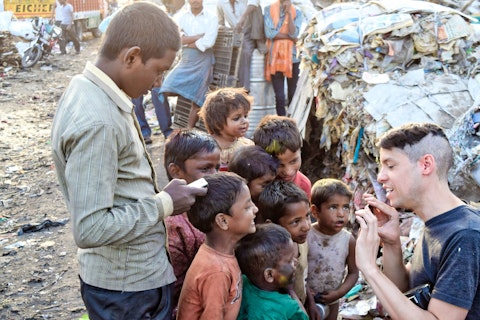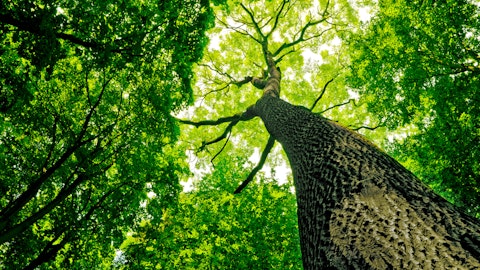In this detailed article, we will discuss countries that are hit with the worst poverty rates in the world and try to understand what makes their economic situation so frail. You can skip our analysis of the most incapacitated economies and head straight to 10 Countries With the Highest Rates Of Poverty.
33 out of 40 countries with the highest rates of poverty are from Africa, owing to the continent’s unstable economic state. According to ISS Africa, Central Africa has the highest extreme poverty rate, averaging 54.8%. Closely following are Southern Africa and Western Africa, with poverty rates of 45.1% and 36.8%, respectively. Currently, South Sudan, Central African Republic, Madagascar, and Somalia top the list of countries with the highest rates of poverty.
As per the World Development Indicators data, the extreme poverty rate in Africa was 43.1% in 1981, almost equal to the global average of 42.8%. However, the next few decades changed the world’s financial status to a great extent. By 2015, owing to economic development, the global extreme poverty rate fell to almost 6%. Contrarily, Africa’s rate, even after improvement, reached 35.5%, almost 7 times higher than the global average.
According to the World Bank’s Somalia Economic Update, poverty is widespread in Somalia, mainly in rural households and Internally Displaced Person (IDP) settlements. Approximately 70 percent of Somalis live below the poverty line, and 90 percent live in multidimensional poverty as of current. Such stats highlight a grave need for education, economic betterment, and skill diversification so that people can raise their living standards. As Somalia is also highly vulnerable to increased natural disasters owing to climate change, the country is currently facing widespread drought with consecutive seasons of poor rains that result in failed crop harvests. The intense weather translates to water shortages, decreased livestock production, and eventually food insecurity.
If we talk about regional poverty rates, Sub-Saharan Africa takes the lead. As per the Asian Development Bank, the number of extremely poor people in Sub-Saharan Africa is 388 million, followed by 256 million in South Asia.
It’s well-known that Africa has long struggled with resource-intensive populations and poverty. To dig deeper into the continent’s economic stats, we have covered 30 Poorest Countries in Africa; give this intelligent study a read.
Companies Working To Alleviate Poverty
Poverty leads to communities being illiterate and intellectually restricted, which eventually limits the skilled workforce. Therefore, poverty eradication is extremely important, especially if the nations want to empower people. In this regard, aside from the governments of countries that have the worst poverty rates in the world, some responsible companies are also taking the lead.
One such name is Mastercard Inc (NYSE:MA), which has a dedicated Center for Inclusive Growth that aims to advance equitable economic growth and financial inclusion around the world. Mastercard Inc (NYSE:MA) achieves this by partnering with governments, NGOs, and other private sector companies to promote inclusive growth. As the company is also a strong advocate for payment digitization, it can increase financial inclusion and make financial services more accessible. In Africa, for instance, Mastercard Inc (NYSE:MA) has launched multiple initiatives to increase digital payment adoption and promote financial literacy. As African countries like Nigeria, Namibia, and South Africa have growing numbers of freelance workers, such digitization can ease their financial woes.
Likewise, JPMorgan Chase & Co (NYSE:JPM)’s corporate responsibility work includes a global philanthropy commitment of $1.75 billion over the next five years (announced in 2018). This program by JPMorgan Chase & Co (NYSE:JPM) includes initiatives to focus on areas like job skills and workforce readiness, small business expansion, and financial capability. One example of JPMorgan Chase & Co (NYSE:JPM)’s work is the “AdvancingCities” initiative, which is a $500 million, five-year initiative to drive inclusive growth and create greater economic opportunity in cities around the world. The firm also supports a number of nonprofits working in countries with high poverty rates.
Another company contributing to alleviate porverty is Microsoft Corp (NASDAQ:MSFT). The company’s philanthropy efforts include programs focused on increasing access to digital technology, education, and job skills in underserved communities. For instance, Microsoft Corp (NASDAQ:MSFT)’s Airband Initiative aims to bring internet access to 100 million Africans by 2025, which can help people in these areas access online education and economic opportunities. Microsoft Corp (NASDAQ:MSFT)’s digital skills initiative also brought digital skills to 25 million people worldwide in 2020.
We have covered some 26 Companies That Donate To Nonprofits for different social, humanitarian, and environmental causes; give this insightful piece a read.

40 Countries With Highest Rates Of Poverty
Our Methodology
We found poverty rate by country in 2023 from the World Bank’s database and ranked nations in ascending order of high poverty rates. To be more precise about these poverty rates, we selected the poverty headcount ratio at $2.15 a day from the World Bank’s indicators. This indicator shows a country’s population percentage currently surviving on less than $2.15 a day and is defined as the threshold of extreme poverty by the World Bank and the UN. Notably, the extreme poverty threshold was $1.90 per day earlier but was revised based on the 2017 PPPs (purchasing power parity).
We also referred to the International Monetary Fund’s World Economic Outlook Report for April 2023 to understand how the said countries’ GDP (Gross Domestic Product) has changed in recent years. To do so, we selected the time frame of 2018-2023 in the IMF Database and downloaded the GDP to report back our findings of the worst poverty rates in the world.
Based on our findings, here are 40 countries with the highest rates of poverty:
40. Mali
Below $2.15 Poverty Rate: 14.8%
Mali’s rural communities bear prevailing poverty. This economic limitation is driven by erratic rainfall that impacts the country’s agricultural output. Moreover, gender inequality and youth unemployment aggravate the impoverishment situation.
39. Sudan
Below $2.15 Poverty Rate: 15.3%
Although Sudan’s GDP is $46 billion (almost $12 billion higher than two years ago), its 15.3% population still survives on less than $2.15 a day. Pervasive economic instability is also fueled by prolonged conflict and environmental challenges.
38. Sao Tome and Principe
Below $2.15 Poverty Rate: 15.6%
Although Sao Tome and Principe have a very small population, it doesn’t mean the country doesn’t face poverty. According to the World Bank, the country’s very limited population hinders large-scale economic development, which eventually means there’s more poverty. The country’s GDP is also $0.625 billion.
37. Micronesia
Below $2.15 Poverty Rate: 16.1%
Micronesia, a cluster of small Pacific islands, suffers from substantial poverty, primarily due to geographic isolation and limited resources. Though local initiatives and international aid attempt to better these conditions, their impact remains.
36. Comoros
Below $2.15 Poverty Rate: 18.6%
Comoros’s population totals 0.9 million, while its GDP is $1.348 billion. However, its extreme poverty rate by country, as per the World Bank, is 18.6%. Moreover, the country’s 48.5% population is multidimensionally poor.
35. Yemen
Below $2.15 Poverty Rate: 19.8%
Yemen’s economy is shattered by a protracted conflict that began in 2015; over 80% of its population depends on aid to survive. Currently, 19.8% of people in the country survive on less than $2.15 a day, which intensifies malnutrition.
34. South Africa
Below $2.15 Poverty Rate: 20.5%
Poverty in South Africa is pervasive, marked by stark income disparities. Historical injustices and systemic inequality affect the majority. With a high unemployment rate, many South Africans live below the international poverty line, experiencing food insecurity and inadequate housing.
33. Guinea-Bissau
Below $2.15 Poverty Rate: 21.7%
According to the International Fund For Agricultural Development (IFAD), a 2010 survey found that 69.3% of people in Guinea-Bissau were poor, of which 33% lived in extreme poverty. Currently, the World Bank’s stats put the country’s poverty rate at 21.7%. The majority of the population is engaged in subsistence agriculture, which is often marred by volatile climatic conditions.
32. Honduras
Below $2.15 Poverty Rate: 22.9%
In Honduras, extreme poverty is ravaged by frequent natural disasters and systemic corruption. As of now, more than 22.9% of the population lives in destitute conditions. Struggling families often subsist on less than $2.15 per day.
31. Ghana
Below $2.15 Poverty Rate: 25.2%
Poverty in Ghana comes from structural challenges, such as limited access to quality education. The country’s socio-economic imbalance poses a serious obstacle to Ghana’s overall progress. Ghana’s current GDP is $66.622 billion, down from $72 billion in 2022.
30. Sierra Leone
Below $2.15 Poverty Rate: 26.1%
Sierra Leone’s GDP is $3.52 billion, and the country’s poverty rate by country as per the World Bank, is 26.1%. Structural issues, like the legacy of a devastating civil war and economic challenges, make these hardships harder.
29. Ethiopia
Below $2.15 Poverty Rate: 27%
Ethiopia’s current GDP is $156.03 billion, almost $30 billion higher than the previous fiscal year. But still, poverty remains a substantial issue in the country. Many Ethiopians don’t have access to basic necessities, healthcare, and education. Efforts for poverty alleviation, while present, must be strengthened to sustainably uplift millions from this cycle of deprivation.
28. Liberia
Below $2.15 Poverty Rate: 27.6%
Liberia, a West African nation, grapples with intense poverty, as its 27.6% population is below the poverty line as of 2023. The aftermath of a brutal civil war, poor governance, and an Ebola outbreak have strained its economy. Despite foreign aid and numerous interventions, poverty reduction has been slow due to infrastructural deficiencies.
27. Togo
Below $2.15 Poverty Rate: 28.1%
Togo’s population is 8.6 million, of which, nearly one-third live in intense impoverishment. Most rural areas lack basic amenities like clean water and electricity. Widespread unemployment and low literacy rates exacerbate the issue. According to the World Food Programme, malnutrition and food insecurity also prevail in Togo.
26. Haiti
Below $2.15 Poverty Rate: 29.2%
Haiti suffers from severe poverty, with over 29% of its population living below the poverty line. Natural disasters, political instability, and limited access to education make poverty eradication harder. Chronic malnutrition and inadequate healthcare are stark manifestations of this reality.
25. Kenya
Below $2.15 Poverty Rate: 29.4%
Despite significant strides in economic growth, poverty remains a stark reality in Kenya. Currently, around 29.4% of Kenyans live below the poverty line and face persistent challenges like unemployment, illiteracy, and regional disparities. Moreover, inadequate access to basic services traps many in intergenerational cycles of impoverishment.
24. Burkina Faso
Below $2.15 Poverty Rate: 30.5%
Burkina Faso’s GDP is $21.067 billion in 2023, and its poverty rate is 30.5%. Subsistence farming is the primary source of income for many, but as it is heavily dependent on unpredictable rainfall patterns, there’s limited potential. The Sahelian country’s landlocked location also hinders economic development.
23. Nigeria
Below $2.15 Poverty Rate: 30.8%
Nigeria has the highest GDP amongst sub-Saharan African countries, currently standing at $506 billion. But since the country’s population is also 213 million, there’s looming poverty. Nigeria’s high employment and coupon drain its resources and result in resource scarcity. Although Nigerian youth is upskilling, with many working remotely in global IT jobs, there’s still a long way to end the country’s economic famine.
22. Chad
Below $2.15 Poverty Rate: 30.9%
Chad’s GDP is $11.962 billion at the time of writing this article, and the country’s poverty rate is 30.9%. Mismanagement and corruption are the main causes behind the country’s battle with poverty. Chad also has a dense population growth percentage which makes fair resource allocation further challenging for the government.
21. Angola
Below $2.15 Poverty Rate: 31.1%
Post-civil war reconstruction, rapid urbanization, and an oil-focused economy have yet to benefit all Angolans. As of 2023, over 31% of the population lives below the poverty line, grappling with food insecurity. While efforts to diversify the economy and enhance social protection systems are underway, disparities persist, often fueled by climate change-induced droughts.
20. Lesotho
Below $2.15 Poverty Rate: 32.4%
Lesotho is a small, landlocked African nation that faces significant poverty challenges. The country’s economic reliance on agriculture and remittances from workers in South Africa leaves it vulnerable to climate change and external shocks. Unemployment is high, while HIV/AIDS, which affects almost a quarter of the population, exacerbates poverty.
19. The Republic Of Congo
Below $2.15 Poverty Rate: 35.4%
Extreme poverty in the Republic of Congo is pervasive and affects over 35% of the population. Rampant issues such as political instability and weak governance stop the country from reaching its full potential. The country’s GDP in 2023 is $13.031 billion.
18. Eswatini
Below $2.15 Poverty Rate: 36.1%
Eswatini is a small African country with a current population of 1.19 million. But despite not having many mouths to feed, the country has a soaring poverty rate. Most of this poverty can be attributed to droughts, dry spells, and erratic rainfalls that don’t let the country grow sufficient crops.
17. Senegal
Below $2.15 Poverty Rate: 39%
Despite being rich in culture and tradition, many Senegalese people grapple with insufficient access to necessities. As a result, many are forced to make heartrending decisions between essential health services and daily sustenance.
16. Papua New Guinea
Below $2.15 Poverty Rate: 39.7%
As of 2023, approximately 39.7% of Papua New Guinea’s population lives below the poverty line and struggles to meet daily needs. The country’s inequality is stark, as wealth from its resource-rich sectors rarely trickles down to the majority of its rural communities.
15. Zimbabwe
Below $2.15 Poverty Rate: 39.8%
Zimbabwe’s current GDP is $29.931 billion, and its population is 15 million. When hyperinflation, poor economic infrastructure, and lack of resources come together, poverty becomes huge in a nation. This is the reason 39.8% of people in Zimbabwe live below the poverty line, and the majority are food insecure.
14. Uganda
Below $2.15 Poverty Rate: 42.2%
As Uganda’s population growth rate is the 8th highest in the world, the countrymen have to face immense struggles to make ends meet. With a population of 45 million and a GDP of $49 billion, the country’s resources are always stretched thin. Uganda’s poverty is also aggravated by unequal land distribution and the long-standing impact of the civil war.
13. Tanzania
Below $2.15 Poverty Rate: 44.9%
Tanzania’s GDP is more stable than other top 10 countries with the highest poverty rates, currently standing at $85 billion. But despite this, nearly 44.9% of the nation’s population is below the poverty line. The major reason for such shocking stats is the lack of an economic infrastructure, which results in no jobs for skilled people and limited growth potential.
12. Afghanistan
Below $2.15 Poverty Rate: 49.4%
Afghanistan is one of the poorest countries in the world. Its poor economic condition has been worsened by decades of conflict and political instability. As of 2023, almost half of the country’s population lives below the national poverty line. Poor infrastructure and unemployment are major problems in the country. Additionally, gender inequality restricts women’s economic participation, further deepening poverty.
11. Niger
Below $2.15 Poverty Rate: 50.6%
Niger is one of the countries with highest poverty rates. Poverty in Niger stems from limited agricultural land, water shortage, and poor resource management. Currently, the country’s GDP is $16.617 billion, and half of its population is living in intense poverty. Niger also has widespread illiteracy, which means the skilled workforce is limited in the country.
Click to continue reading 10 Countries With Highest Rates Of Poverty.
Suggested Articles:
- 25 States with the Lowest Poverty Rates in America
- 10 Poorest Arab Countries
- 20 Poorest Countries in Europe
Disclosure: None. 40 Countries With Highest Rates Of Poverty is originally published at Insider Monkey.



